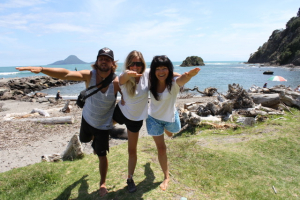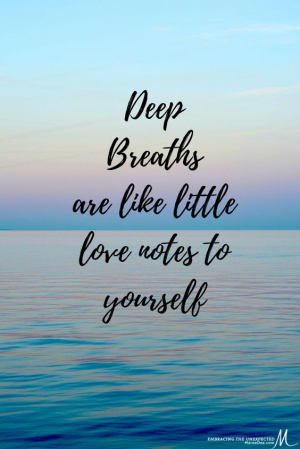
Displaying items by tag: breathe
Potential Benefits For You From Therapeutic Massage
Benefits of massage
One of the immediate benefits of massage is a feeling of deep relaxation and calm. This occurs because massage prompts the release of endorphins – the brain chemicals (neurotransmitters) that produce feelings of wellbeing.
Levels of stress hormones, such as adrenalin, cortisol and norepinephrine, are also reduced. Studies indicate that high levels of stress hormones impair the immune system.
Some of the physical benefits of massage and myotherapy include:
- reduced muscle tension
- improved circulation
- stimulation of the lymphatic system
- reduction of stress hormones
- relaxation
- increased joint mobility and flexibility
- improved skin tone
- improved recovery of soft tissue injuries
- heightened mental alertness
- reduced anxiety and depression
60 minute Therapeutic Massage $75
30 minute Therapeutic Massage $40
Ring or message me on 0274 96 96 33 for an appointment that suits you.
I am situated at 19B Golf Road, Mount Maunganui. Thanks Leonie
When Mindfulness Fails You: Tools for Managing Anxiety
By Julie Peters
It’s 4am. I’m spiraling deep into what I call the “nightmare fantasy”: imagining the absolute worst possible scenario, how I would react, what would happen next, and spiraling on and on into the hell of my imagination.
I have an anxiety disorder that is mostly managed in large part thanks to yoga and meditation. Every now and then, however, something tips a few pebbles off my anxiety cliff and suddenly I’m in a 4am avalanche.
On this particular sleepless night, I could see myself overreacting. I thought, “You’re overreacting. Calm down.” I also know, though, that fighting like this can make the situation worse. So I stopped fighting. Then I went so deep down the catastrophizing rabbit hole that I bolted up and actually screamed out loud.
Has anyone ever told you to “just stop worrying?” In the yoga world, we can get the message that all we need to do for a happier life is to think positively, and if you ever have negative thoughts, you’re doing it wrong. From the Tantric yoga perspective, however, all experiences, including uncomfortable ones, have value, and there’s danger in only focusing on what’s pretty and sweet. Trying to convince yourself that everything is finewhen it’s not exacerbates, rather than abates, anxiety. You can’t “just” stop worrying.
Stress reactions come from your amygdala, the primal part of your brain that governs your nervous system. Your prefrontal cortex is the rational, conscious part of your brain. When you try to force yourself to calm down, your prefrontal cortex is trying to overpower your amygdala, which only ramps up the primal fear response. You can’t tell your amygdala what to do.
You can, however, acknowledge the disconnect. Yoga and meditation are useful in that they can teach us to wake up what’s called the buddhi mind, the mind that observes the mind. I had this part down: I could see the problem, but couldn’t stop it from happening. I needed some new tools, and I wasn’t getting them from yoga.
Cognitive Behavioural Therapy is a technique that works from the premise that thoughts affect feelings which affect behaviours which affect thoughts and so on. It’s very challenging to change your feelings, but you can work with your thoughts and behaviours. When I see myself beginning to spiral, I can ask myself:
What thought is contributing to this feeling?
What evidence do I have that this thought is true?
What else could be going on?
What evidence do I have for those alternatives?
When I see myself internally reacting as if my worst fear is already happening, these questions can help me pause my nightmare fantasy and remember that other interpretations are also valid. I can hold the different possibilities and wait to react until I have more information. I can know that it’s okay to not know.
It’s not uncommon for yogis like me to get disillusioned when the initial euphoria of the practice wears off. The world doesn’t stop being confusing and cruel just because we decide to think positively. Stepping outside of my practice to learn these new techniques has actually returned me to my yoga: fundamentally, yoga teaches us to stay present with a rich and varied world and to honor the beauty and ugliness both inside and outside of ourselves. For me, this is much more interesting than insisting on living in a place that’s crowded with rainbows and flowers. This way, I can get back to sleep. Then I can do my yoga in the morning.
3 Things You Should Never Say to an Anxious Child (and What to Do Instead)
It's normal to be anxious, and it's normal to react poorly to anxiety in others! Here are some tips if you're around anxious children.
It's normal and healthy for children (and adults for that matter) to feel anxious from time to time. However, when your child gets caught in the worry cycle, ruminating on his thoughts, this can lead to some pretty intense emotional toxicity. Suddenly, what started out as a little stress turns into a rather strong narrative of helplessness, fear, and insecurity. What your child is worried about will likely dissipate, but as a parent, it can be very frustrating and anxiety-provoking to watch!
How you react can make a difference. The things you say and don’t say can either inflame or soothe your worried child. Here are three statements you might want to consider avoiding, along with three things to do instead:
1. Calm Down. I don’t know about you, but when someone tells me to calm down when I am upset it only makes me feel worse. Here's the thing: When you tell children to calm down, immediately they are going to translate that into "This person doesn’t understand, they think I am overreacting, or they assume it is my fault."
As a result, children may get frustrated and angry because they feel you are taking sides or judging how they feel. They may become concerned that you will attempt to take over the situation, which in their minds will only make matters worse. Children who are anxious often report feeling out of control. When you attempt to take control of a situation by telling them to calm down, this can make them feel like they have lost control.
Instead: Rather than telling children to calm down, adults ought to focus more on calming themselves down. Once you feel the hairs sticking up on the back of your neck or tension in your face, this is a sign that you are going into reactivity. When you tell your child to calm down or chill out, this is a way you are attempting to manage your own anxiety. Instead, focus on your exhale while squeezing the muscles you use to hold your pee when you have to go to the bathroom. This will bring the tension down.
2. Don’t Worry About It. This statement can come off as condescending. While it might be a quick fix when your children are young, as they grow older they will catch on to you. For example, if they see that you struggle with worry, they are less likely to take your advice seriously. When you say "Don’t worry about it," it puts a strain on children to try to figure out how to let it go. I don’t know about you, but whenever I focus on attempting to let go of something it somehow intensifies the problem.
Instead: Focus on calm behavior. For example, rather than trying to figure out what to say, be an illustration for what you want your child to focus on. In this case, with a worried child you want them to focus on calming down. So rather than saying "Don’t worry about it," instead listen with full attention in a calm way.
3. Take a Breath. While it may seem like teaching your child to take a deep breath would be the right thing to do, the challenge is that anxious children are likely to take a dramatic inhale or resist their breath altogether. Breathing as a tool for calming down is a skill you develop. Without some guidance, children are likely to make their anxiety worse. This is because when you take a quick inhale, you can inflate the upper chest, making symptoms worse! This will make it less likely your child will use that strategy in the future.
Instead: Ease your way into breathing. For example, if your child is worked up, consider going for a stroll, swinging on a swing set, or offering your child a nice glass of cold water. Mindful practices such as these teach your child that calming down is a process not a quick fix. When we are quick to react with statements such as "Take a breath," this sends a message to your child that calming down should be quick and easy.
Rest assured that most of what your children are worried about now will at some point in the future be another hurdle they have crossed. While that might seem hard to picture when you are in the throes of anxiety, on the other side of all those worries are opportunities for you and your child to develop a sense of faith, trust, and patience for the process. So rather than getting caught up in what you will say, instead choose to be present to the situation without having to come up with the perfect words to change or alter the situation. Once the two of you feel settled and connected, then you can move on to coming up with solutions and ideas that may help.
Less Stress & Anxiety
Mummy Micro Moments
Now that the kids are back at school, take a few moments for yourself to ground & breathe.
Benefits of Balancing Asanas are many:
Helps induce physical balance
Develops a balanced mind
Enhances concentration
Balances the nervous system
Relieves anxiety & stress
Brings your focus back to the breath & present moment
Opens up the front flexor line of fascia to help create alignment
Activates your psoas muscles with the rest of your abdominal core muscles for a strong, stable core
Helps with natural spinal alignment
Helps to release unnecessary tension you have invited in
Yoga is not how high you can hold up your leg or deep you can get your squat. It is about connection with the breath & staying true to you own practice, what ever that is today.
Set yourself achievable goals that don’t overwhelm you ie two minutes twice daily, because you deserve it!
How Mental Healing Can Still Flourish in the Midst of COVID-19
By Breanna Pereira, NASM-Certified Personal Trainer and NASM-Certified Nutrition Coach - May 2020
How fitting that the anniversary of the acceptance of my depression would fall around Mental Health Awareness Month. Last year, I had paid no attention to it; this year, I am excited to pay homage to it. However, like most celebrations over the past couple of months, this will be spent with the looming effects of the global pandemic COVID-19. It’s hard to believe that it has almost been a year since I’ve had one of the most pivotal conversations of my young adult life—and it started with one simple question from a coworker:
“How are you really doing?”
This led me to admit to something I had been resisting for almost 10 years: I have depression and I need professional help in order to overcome it. I had mastered the art of masking my mental distress, but I eventually learned that masking is not a cure. It was a painful combination of fear, shame, and resistance.
As a health fitness specialist in the San Francisco/Bay Area, I am supposed to be the hype (wo)man. The one who motivates others to want to make changes to increase their quality of life, but that goes far beyond a number on a scale. It also entails the social, emotional, and spiritual aspects of life. I realized that if I wanted to be authentic in my career, it was going to require me to step outside of myself and seek help. In order to celebrate change, and to encourage it in others, I needed to embrace it wholeheartedly in my own life first.
I remember sitting in the waiting room of my therapist’s office and filling out the initial assessment forms.
Circle what applies to you.
Circling depression is what made it all real.
Overcoming the Stigmas Around Mental Health
Depression is something that I’ve known has always lived inside of me, but I was too afraid to say it out loud. I was afraid of the stigma that comes with the words: depression, anxiety, and therapy.
After a handful of sessions, my therapist helped me realize that those stigmas would only become a reality if I chose to breathe life into them. I have to constantly remind myself that I am on a journey of self-discovery, understanding, and self-compassion.
As a “recovering perfectionist and an aspiring ‘good-enoughist’” (thank you, Brené Brown), this has been an incredibly difficult year for me. Taking the time to chip away these walls I have built and become comfortable with openness and transparency is one of the scariest things I have ever done, but knowing that I have been able to overcome each fall by embracing and learning from each situation were signs of growth.
That growth has been tested daily since the start of this pandemic. Not only have I had to call on existing tools to preserve the progress that I’ve made, but I have also been pushed to develop new tools to help overcome the challenges that have risen over the past seven weeks. The biggest question that needed to be addressed: What if I can’t handle this anymore? Will that mean that all the progress I’ve made over the past year will have been for nothing?
In an attempt to calm my anxious mind, I have been able to uncover one of the most important tools: reflection. Now is the time to reflect on just how far I’ve come and to start actively developing a routine that utilizes each of the tools I have learned over the past year. While everyone is different and deals with their journeys of self-discovery and mental health differently, these are some tools that have helped me when I’ve recognized it’s time for action.
1. Read
By reading an hour before bed, I am able to give my mind an opportunity to escape our crazy pandemic reality and to start exploring new techniques to facilitate growth. These are some books that ha ve helped to provide that for me:
ve helped to provide that for me:
- Dare to Lead by Brené Brown
- A Woman Is No Man by Etaf Rum
- Gods of Jade and Shadow by Silvia Moreno-Garcia
- Daring Greatly by Brené Brown (currently reading)
2. Journal
I found a journal that has “BLOOM” written across the cover. For me, this serves as a reminder that the “blooming” process takes time, and that the environment I create will determine whether I will wilt or bloom. I don’t journal every day because a strict regimen in regard to self-expression creates a toxic perfectionist monster in my mind. Instead, I use this tool when I need a place to vent, to remind myself that I am strong, but that I don’t need to have everything figured out right now.
3. Exercise
Today, not only is fitness my career, but it has also become a physical representation of growth and success. I have a personal trainer. He and the rest of the Red Dot Fitness community have helped me uncover strength that I didn’t realize I had. By having a place where I can be surrounded by inspiring and passionate individuals, I always walked out of there feeling renewed.
During these weeks of quarantine, they have still been able to provide this sense of revival for me through live workouts and personal training sessions. They have been able to provide a sense of community even during this time of social distancing.
4. Meditate
In the past, I had tried to implement meditation into my routine, but it never worked because my approach to meditation was all wrong. The idea of being and remaining present is difficult for a naturally anxious perfectionist like me, but the guided meditations from Headspace have taught me that it is natural for the mind to go off track. Actively navigating my thoughts and emotions, when times get hard, is something I never thought I had the strength to do.
Every tool in my toolbox may seem quite simple, but what makes them highly effective is that I’ve discovered how and why they give me strength. I’ve allowed myself to gain a better sense of self-compassion, a working understanding of the importance of communication, and the power that arises when you take the time to slow down and breathe—and it’s hard to believe that it all started with one simple question of how am I really doing?
Recognizing your mental state, and then healing, doesn’t happen overnight; it is an ever-growing process. I hope that by sharing in my story you might allow others some room to breathe and practice being kind to yourself--especially during these trying times. While I may be celebrating one year of healing this month, practicing and respecting your mental health is a lifelong commitment, and I will forever be walking that journey alongside you.
Just Breath
What can I do to support & love my body?
Breathe work - breathe is key & free! A negative thought or belief will have an effect on your physical body. With this awareness, focus on the following.
Place your hands on your heart and take 3 deep breathes, this will help calm your sympathetic nervous system & bring you into the present moment.
Count to 4 while you inhale through your nose
Hold your breath while counting to 7
Count to 8 as you slowly exhale through your mouth
This helps you to release any fear, anxiety, tension, or energy that’s not serving you.
Repeat at least 2 more rounds, tuning into your body.
Carry on, for a few more deep breathes, if you feel you need too, your body will thank you for it.
Be gentle on yourself. If breathe work is new to you, start off slowly.
Try doing this once a day either first thing when you rise or before you to to bed.
It's the little daily gifts to yourself, that create big shifts in your wellness.
Mahalo
How Do You Generate Energy?
The tension we feel in our bodies often comes from weak & dysfunctional breath patterning. When our breath is powerful & balanced, it creates a sense of ease throughout our physical & emotional body. When we are not breathing well, our spine is collapsed, & the diaphragm is weakened, so we begin to rely on the neck & back muscles to hold up our structure & help us breathe.
Weak breathing habits lead to poor posture, which cause tightness & tension as muscles assume the burden of functions they are not designed to perform. It is no longer just the elderly who show signs of poor posture, as habitual slouching & poor alignment increasingly affect young people as well.
Observing muscle balance & posture may lead us to conclude that a slouched person might be holding feelings of depression. Are they depressed from slouching? or are they slouching from depression? If we focus on changing patterns through core breathing, our body will naturally feel light, & our mental energy will be free to express itself. We can become enslaved in a stress cycle simply from poor breathing & the resultant bad posture & negative feelings that this cycle can create. This is an example of carrying "issues in our tissues." When we are aligned & breathing well, it is actually difficult to frown. Conversely, it becomes difficult to smile when one is slouching. Poor breathing leads to poor alignment, which leads to depression, which leads to poor alignment, which leads to poor breathing, & so on. It's easy to become stuck in this stress cycle when our modern lifestyles demand that we spend so many of our waking hours in a chair. Utilising YogAlign core breathing to align our spine & balance our muscular-fascial web, we can positively impact our reservoir of mental & physical energy and the quality of our thoughts.
Your breath defines your movements, your posture, your mood, and eventually, determines your life span. Learn to breathe with purpose & passion, in order to re-create who you are - a vital, passionate & loving being!
Much Love to Michaelle Edwards creator of YogAlign
Your Office Chair Is Killing You!
Your office chair is killing you!
As children, our discs are more watery in substance, but the discs thicken with age & poor posture, leading to less mobility & stiffness of the spine. The thickening is a result of how our fascia system works: where there is tension or compression, the body will produce an excess of collagen fibres, thickening the discs. As the disc thickens, the gel-like nucleus losses water & compresses, leading to spinal nerve impingement, pain & stiffness.
We can assist our disc physiology by practicing good alignment & doing therapeutic exercises that increase spinal extension.
Avoiding caffeine, cigarettes, & alcohol can help disc hydration, since these substances act as diuretics.
Practicing Yogalign that optimises engagement of the natural spinal curves can be like getting a good nights sleep, helping your discs & vertebrae to remain youthful & supple.
Sitting well is an essential tool for surviving the modern lifestyle which often revolves around sitting in chairs. Learning to correct poor breathing habits & aligning the spine can fix much of what is hurting in your body.
Modern life with increased use of technology can lead to round shoulders, kyphosis & dowagers hump & premature ageing!
Contact me for an appointment if you would like to learn some simple tools to increase your awareness of how you are breathing & moving, so you can feel more at ease in your own body & have more energy everyday ... perfect time to get fit & supple for all those fun summertime activities ?
A Little Free Self-Nourishment @ Sweat Sunday - YogAlign Yoga At Lululemon Mt Maunganui
Contact Leonie Main
m: +64 (0) 274 96 96 33
19B Golf Road, Mount Maunganui 3116, New Zealand
Facebook: Gypset Life












